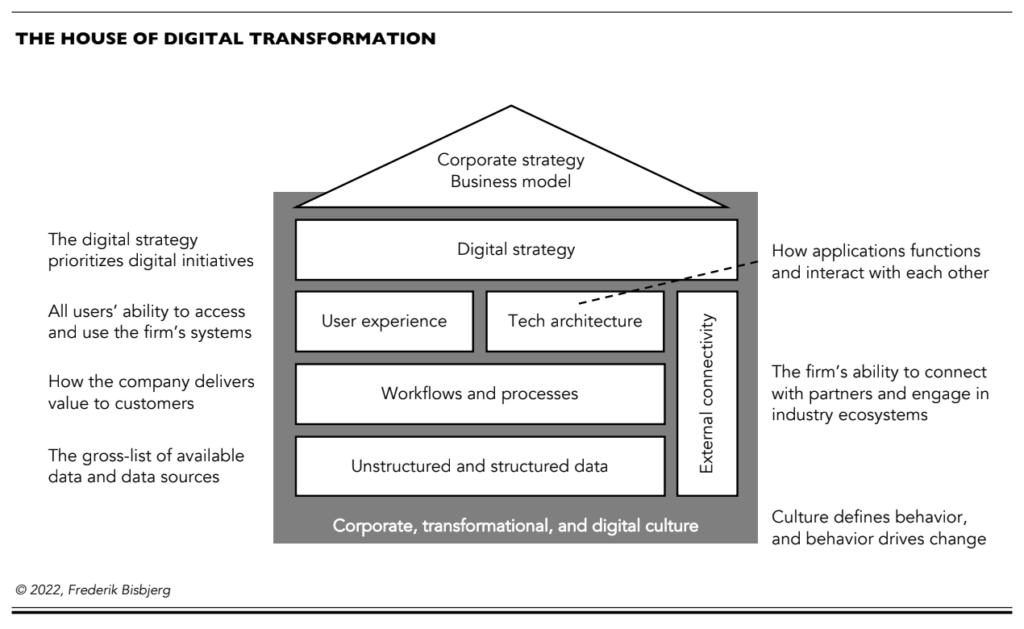
Council Post: The Survival of the Firm: Digital Transformation
- By AIM Research
- Published on
One of the most significant advantages of digital transformation is the ability to gain valuable insights from data.


The term “digital transformation” is often used to describe various changes taking place in companies today, but what does it truly entail? Digital transformation is a comprehensive process that involves a wide range of activities within and outside the organization. In essence, it refers to the process of reshaping how a company operates to remain competitive in the digital era. This transformation encompasses the infusion of digital tools, methods, and processes into every aspect of the company’s operating model, including processes, business models, products and services, customer experience, technology, and corporate culture.

A key aspect of successful and competitive businesses in the future is the ability to deliver products and services efficiently, while keeping costs low and maintaining high service levels. Achieving this requires the automation and optimization of the firm’s processes, which lies at the core of any digital transformation initiative. By automating and optimizing processes, companies can enhance their efficiency and responsiveness, leading to improved performance and competitiveness.
Moreover, digital transformation involves a shift in the company’s business model, exploring new ways to generate revenue and distribute products and services to customers. For instance, the adoption of digital tools and channels can eliminate the need for intermediaries, enabling companies to directly connect with customers.
Digitalization of products and services is also integral to digital transformation, ensuring that the company remains relevant and competitive in its value proposition to customers and partners. While some traditional players may fear that digitalization will cannibalize their existing business, it is crucial to understand that digital development continues to progress, and it is better to embrace transformation than to lose market share to competitors.
Transforming processes, business models, and products and services leads to changes in the customer experience, which is another essential aspect of digital transformation. Digital innovations provide new ways of interacting with customers, streamlining communication and improving customer interactions.
At the heart of digital transformation projects lies the firm’s technology architecture, which encompasses the various applications the company uses and how these systems interact with each other. A robust and flexible technology architecture can provide a competitive advantage, enabling faster transformation and improved performance.
However, no digital transformation is possible without the commitment and skill of the employees involved. Cultural change is a crucial element of any transformation initiative, as it involves changing how business is done, requiring employees to adapt to new processes and habits.
Behind the digital transformation of a company are several digital drivers that support and enable the process. These drivers involve integrating digital elements into all areas of the business, such as artificial intelligence (AI) and machine learning. AI is a subset of digital transformation that involves analyzing datasets to find patterns and dependencies, while machine learning focuses on identifying patterns in data to generate formulas for future predictions.
Intelligent process automation is another critical driver that involves automating complex processes while incorporating intelligent decision-making capabilities. Furthermore, the Internet of Things (IoT) plays a significant role, connecting devices that constantly provide feedback to improve processes.
The adoption of digital transformation is imperative now more than ever, as the pace of technological development accelerates, and the market experiences disruptive changes. Companies that fail to embark on this journey risk falling behind competitors and losing market share.
Digital transformation is an ongoing process, as technology continuously evolves, and market demands change. Embracing digital transformation as a part of the company’s DNA enables businesses to stay agile and responsive to emerging trends and challenges.
One of the most significant advantages of digital transformation is the ability to gain valuable insights from data. With the integration of AI and data science, companies can leverage their vast amounts of structured and unstructured data to extract meaningful information. AI-powered algorithms can analyze historical sales data, customer preferences, market trends, and external factors to generate accurate demand forecasts, optimize inventory levels, and streamline production schedules.
Additionally, AI-driven optimization algorithms can enhance various aspects of the supply chain, such as inventory management, transportation routes, and production planning. These algorithms consider multiple variables and constraints, enabling organizations to make data-driven decisions that minimize costs, reduce lead times, and improve overall operational efficiency.
Moreover, AI technologies can identify and mitigate risks in supply chain management. By analyzing diverse data sources, including supplier performance, market dynamics, and geopolitical factors, AI can detect potential disruptions and develop contingency plans. This proactive approach enhances resilience, maintains continuity in operations, and minimizes the impact of unforeseen events.
Furthermore, AI enhances visibility and transparency throughout the supply chain. Real-time data analytics and monitoring provide insights into the performance of suppliers, logistics partners, and other stakeholders. This transparency enables better collaboration, improved communication, and streamlined processes, ultimately leading to enhanced customer satisfaction and loyalty.
Despite these positive impacts, the integration of AI in demand-supply operations can also raise concerns about its impact on jobs. AI technologies can enhance efficiency and optimize processes, but they can also automate certain tasks traditionally performed by human workers. Automation of routine tasks such as data entry and data analysis may reduce the need for manual labor in these areas, potentially leading to job displacement.
However, it is crucial to understand that AI technologies can also create new job opportunities. As AI becomes more prevalent in supply chain management, organizations may require employees with a blend of technical skills, such as data analytics and AI knowledge, along with domain expertise in supply chain management. This shift in skill requirements may lead to the need for upskilling or reskilling existing employees to adapt to the changing job landscape.
To kickstart the digital transformation journey, organizations can leverage existing improvement and transformation projects, incorporating them into a comprehensive overview of ongoing and planned initiatives. This inclusive approach ensures alignment among stakeholders and business unit leaders, fostering buy-in and prioritization of projects, even those not initially part of the digital transformation program. Guided by the House of Digital Transformation framework, crafting and aligning the digital strategy with the corporate mission and vision provides direction for prioritizing transformation elements such as user experience, technology architecture, workflows, processes, data, and external connectivity. By mapping current activities and challenges through collaborative meetings and interviews, organizations gain valuable insights to form a starting point for their digital transformation odyssey.
This article is written by a member of the AIM Leaders Council. AIM Leaders Council is an invitation-only forum of senior executives in the Data Science and Analytics industry. To check if you are eligible for a membership, please fill out the form here.

Frederik is a seasoned international business leader who specializes in driving digital transformation and business model innovation. He is currently the Chief Transformation Officer at AXA Global Healthcare, and he also holds the prestigious position of Head of MENA and Digital Transformation Specialist at the Digital Insurer, the world’s largest knowledge base on digital insurance boasting over 35,000 active members.
📣 Want to advertise in AIM Research? Book here >

Cypher 2024
21-22 Nov 2024, Santa Clara Convention Center, CA
A Vendor Briefing is a research tool for our industry analysts, and an opportunity for a vendor to present its products, services and business strategies to analysts who cover the vendor specifically or a related technology or market.
AIM Research encourages technology vendors and agencies to brief our team for PeMa Quadrants, when introducing a new product, changing a business model, or forming a partnership, merger, or acquisition.